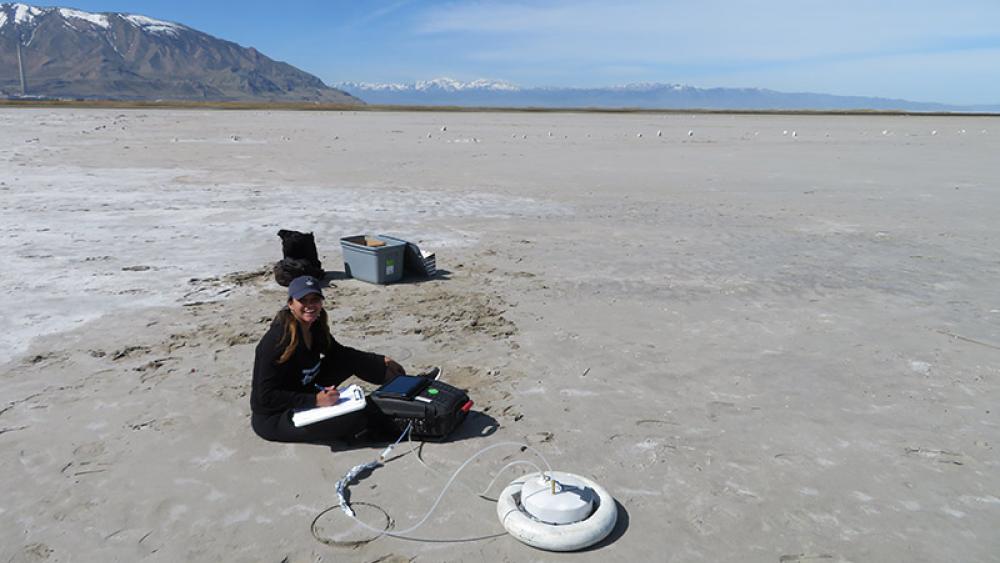
Fieldwork gas sampling. | Photo: Soren Brothers
Salt lakes are usually located in arid regions or deserts, which means that the concentration of salts and minerals in the water are constantly increasing due to high evaporation. Human-induced climate change and interventions such as water extraction can greatly reduce the water level and further accelerate salinization. Well-known salt lakes such as the Aral Sea, Lake Urmia, the Caspian Sea and the Great Salt Lake, which was the subject of the study, are increasingly drying up.
Increasing desiccation of the Great Salt Lake in Utah: 7 percent more greenhouse gas emissions for the state
“Human-caused desiccation of Great Salt Lake is exposing huge areas of lake bed and releasing massive quantities of greenhouse gases into the atmosphere,” said Soren Brothers, who led this research and is ROM’s Allan and Helaine Shiff Curator of Climate Change.
The research team measured carbon dioxide and methane emissions from the exposed sediments of Great Salt Lake, Utah, from April to November 2020, and compared them with aquatic emissions estimates to determine the anthropogenic greenhouse gas emissions associated with desiccation. Calculations based on this sampling indicate the lake bed emitted 4.1 million tons of greenhouse gases to the atmosphere, primarily (94%) as carbon dioxide, constituting an approximately 7% increase to Utah’s human-caused greenhouse gas emissions. “The significance of lake desiccation as a driver of climate change needs to be addressed in greater detail and considered in climate change mitigation and watershed planning, emphasized Soren Brothers.
The higher the temperature, the more greenhouse gases are released
Measurements of carbon dioxide and methane gases were made every two weeks from the dried-up lake bed using a portable greenhouse gas analyzer attached to a closed chamber. Seven sites at one location at the south end of the lake were visited repeatedly over the course of the year, and another three locations were sampled during an intensive three-day campaign to determine spatial variability across the lake, which at 1,700 square miles (4,400 square kilometres) is the largest saline lake in the western hemisphere. As methane is 28 times more powerful a greenhouse gas than carbon dioxide, the global warming impact of these emissions was calculated as “carbon dioxide equivalents” to account for the greater impact of methane. Ultimately, these data indicated that greenhouse gas emissions from the dried lake bed were strongly and positively related to warm temperatures, even at sites that have been exposed for over two decades.
Before the lake dried up, it hardly released any greenhouse gases
To determine whether the lake historically would have been a significant source of greenhouse gases, the team carried out measurements of near-shore greenhouse gas emissions from the lake, as well as analyzing water chemistry collected by the team and government data sets. Together, these analyses showed that the original lake was not likely a significant source of greenhouse gases to the atmosphere, making the dried-up lake bed a novel driver of atmospheric warming.
IGB researcher Dr. Tobias Goldhammer is a biogeochemist and co-author of the study. He explained the physico-chemical process: “When salt lakes lose water due to increased evaporation, the salt concentration rises – sometimes higher than in the sea – and this also changes the solution equilibrium for gases such as carbon dioxide, which is less soluble in saltier water. In addition to the rising water temperature, this is another factor why such lakes can store less carbon dioxide. We compared current and historical measurement data on the chemical water components of the Great Salt Lake with geochemical models and estimated the exchange of carbon dioxide between the water and the atmosphere. We came to the conclusion that the water body did not contribute significantly to the release of greenhouse gases in the past – and does not do so today, in contrast to the areas that have fallen dry.
As climate change exacerbates drought in arid regions, desiccation of rivers and lakes may be contributing to climate change feedback loops and should be considered in assessments of global greenhouse gas output as well as reduction policies and efforts.
Read the article in One Earth >
Read the original press release of ROM >
Desiccating freshwaters also release greenhouse gases:
Other studies have shown that dessicating freshwaters can also be a source of greenhouse gases: A study with IGB researcher Prof. Hans-Peter Grossart, published in the journal Science of the Total Environment in 2022, calculated that dry inland waters release a total of around 2.7 million tons of methane per year worldwide. This corresponds to around 75.6 million tons of carbon dioxide equivalents. Read more >






